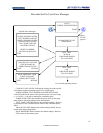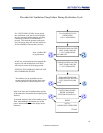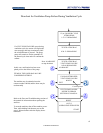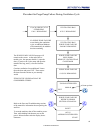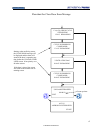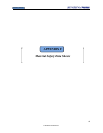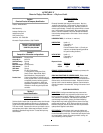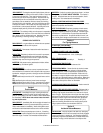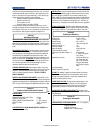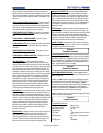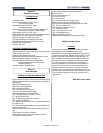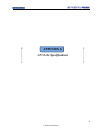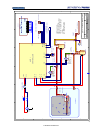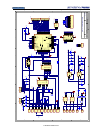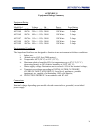
71
OWNER’S MANUAL
to diffuse out of the gas release bag and into the room. At one full
minute after activation there is less than 1 ppm measured at a dis-
tance of 18 inches from the gas release bag. In the case of a pre-
mature activation the operator should immediately:
• Place the Anprolene ampoule inside the sterilizer
• Close the sterilizer door
• Turn the power on; and
• Press the button to the right of PURGE.
This will cause the purge and ventilation pumps to turn on and
evacuate the ethylene oxide from the sterilizer and exhaust it from
the workspace. Allow a full 14 hour cycle before you open the door
and remove the used Anprolene ampoule and dispose of it.
HANDLING AND STORAGE PRECAUTIONS:
Have established
handling and emergency response procedures in place prior to use.
Make sure that the sterilizer is properly grounded. Protect contain-
ers from physical damage and regularly inspect them for cracks or
leaks.
ENGINEERING CONTROLS:
Ethylene oxide, a major fire hazard,
can burn in the absence of oxygen. All electrical devices used in
areas processing or handling ethylene oxide must be engineered
and designed to the applicable local electrical/fire codes. Safe-
guards can include designing electrical devices as explosion proof
and/or intrinsically safe. ATTENTION:
Ethylene oxide vapors are
colorless and odorless above OSHA’S permissible exposure level.
An air monitoring system and/or AirScan® badges are recom-
mended to determine airborne exposure levels.
STORAGE SEGREGATION:
Store ethylene oxide in a cool, dry,
well-ventilated area away from incompatible chemicals and sources
of ignition. Store Anprolene® refill kits upright; do not drop and
move in a carefully supervised manner. DO NOT STORE IN
DIRECT SUNLIGHT.
SHIPPING AND STORAGE CONTAINERS:
(See 49 CFR 173.4)
All Anprolene® refill kits containing ethylene oxide are packaged and
shipped in accordance with the small quantities exemption under 49
CFR 173.4(c) and DOT approval CA 9803005 issued April 9, 1998.
EX-
POSURE LIMITS:
OSHA ACTION LEVEL (8 HR. TWA) 0.5 ppm
OSHA PEL (8 HR TWA) 1 ppm
OSHA 15 MINUTE EXCURSION LIMIT 5 ppm; 9 mg/m3
ACGIHTLV/TWA 1 ppm; 1.8 mg/m3
IDLH: 800 ppm
EYE PROTECTION
: NEVER WEAR CONTACT LENSES when
working with ethylene oxide.
VENTILATION: Install and operate general and local exhaust venti-
lation systems powerful enough to maintain airborne levels of ethyl-
ene oxide below the OSHA PEL in the worker’s breathing area.
AAMI / ANSI ST41 Good Hospital Practice: Ethylene Oxide Steriliza-
tion and Sterility Assurance Guidelines, Section 3.4 recommends a
minimum of 10 room makeup air changes per hour. Emission con-
trols must be in compliance with Federal, State and local regulations.
OTHER PROTECTION
: Sterilizer must be electrically grounded/
bonded. Practice good personal hygiene; always wash thoroughly
after using this material. Do not eat drink or smoke in work area.
Boiling Point: 50.9ºF (10.5ºC)
Freezing Point -169º F (-111.7ºC)
Specific Gravity: 0.871 at 20ºC
Vapor Pressure: 1094 mm Hg @ 20ºC
Vapor Density (Air =1) 1.5
Solubility in Water: 100%
Molecular Weight: 44.06 gms/mole
Percent Volatile by Volume 100%
Evaporation rate (Butyl Acetate = 1) Not applicable
PH: 7, neutral (100 grams/
liter in water)
Appearance and Odor: Colorless liquid or gas
with sweet ether-like
odor. Odor threshold:
261 ppm (detectable);
600-700 ppm recogniz-
able).
Log Octanol/Water
Partition Coefficient (log Kow): -0.3
STABILITY:
Material is stable for extended periods in closed air-
tight, pressurized containers at room temperature, under normal
storage and handling conditions. Vapors may explode when ex-
posed to common ignition sources.
CONDITIONS TO AVOID:
Storage at warm temperatures or any
exposure of storage or shipping containers to hot temperatures.
Prevent exposure to all sources of ignition such as heat, flame,
lighted tobacco products, or electrical or mechanical sparks.
HAZARDOUS DECOMPOSITION PRODUCTS:
Ethylene oxide
undergoes thermal decomposition to form carbon dioxide and carbon
monoxide gases.
TOXICOLOGICAL- ACUTE INHALATION:
LC50 (1 hr. exposure)
5748 ppm (male rat)
4439 ppm (female rat)
5029 ppm (rat – combined sexes)
Section 7
Handling and Storage
Section 8
Exposure Controls/Personal Protection
Section 9
Stability and Reactivity
Section 10
Toxicological Information
© Andersen Products Ltd



